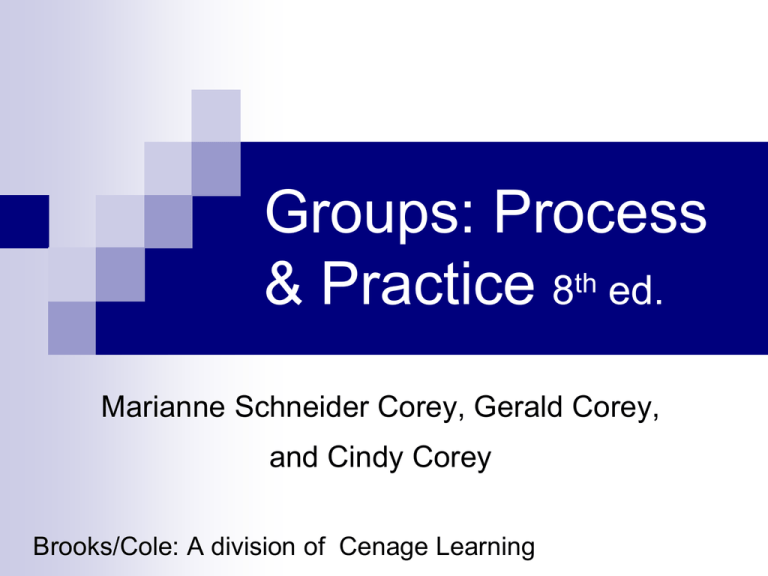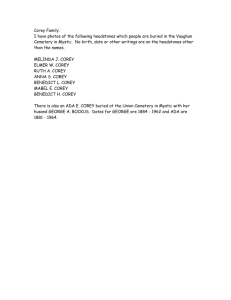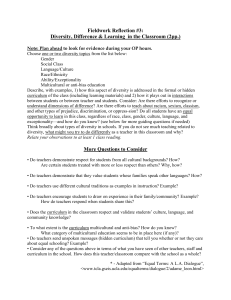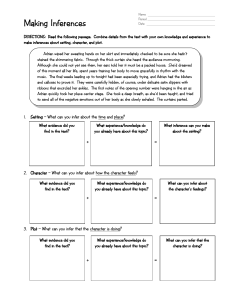Groups: Process and Practice- 6th ed.
advertisement

Groups: Process & Practice 8th ed. Marianne Schneider Corey, Gerald Corey, and Cindy Corey Brooks/Cole: A division of Cenage Learning Groups: Process & Practice 8th ed. Chapter 1: Introduction to Group Work The Corey’s Perspective on Groups Groups are not a second-rate approach to helping people change Groups are the treatment of choice Groups offer a natural laboratory where people can experiment with new ways of being Members’ the group interpersonal difficulties get played out in Group Process Group process – all the elements that are basic to the unfolding of a group from beginning to end Examples: group norms generating trust level of cohesion how conflict emerges in a group patterns of resistance intermember feedback healing forces within the group stages of group development Group Techniques Group techniques – leader interventions aimed at facilitating movement within a group Examples: conducting initial interviews asking a member to role-play a conflict challenging a member’s belief system suggesting homework Group Techniques Techniques should be: presented as a choice—members should be invited to experiment with new behaviors introduced in a sensitive and timely fashion used with consideration for the member’s cultural background and have a rationale should be abandoned if proven ineffective developed in response to what is happening in the here-and-now The Theory Behind the Practice An integrative conceptual framework -involves the thinking, feeling, and behaving dimensions and is a challenge to create and implement Technical eclecticism – based on utilizing techniques from a variety of theoretical models Theoretical integration – a conceptual and theoretical creation beyond mere blending of techniques Various Types of Groups Task groups – aims to foster accomplishing identified work goals Psychoeducational group – aims to educate wellfunctioning group members who want to acquire information and skills in an area of living Group counseling – aims at preventive and educational purposes — utilizes methods of interactive feedback within a here-and-now time framework Group psychotherapy – aims at remediation of in-depth psychological problems — often focuses on past influences of present difficulties Brief Group Therapy BGT- time limited, structured, last 2 to 3 months, and consist of 8 to 12 weekly sessions Facilitators of BGT-need training in group process and brief therapy Advantages of BGT well suited to the needs of both clients and managed care cost-effective widely applicable to diverse client populations and problems can be used in different settings (e.g., school and community agencies) A Multicultural Perspective on Group Work Achieving cultural competence is a lifelong journey Effective group work involves considering culture of participants Group workers must have awareness, knowledge, and skills to effectively deal with diverse membership Cultural similarities and differences need to be addressed in a group A Comprehensive Definition of Multicultural Group Work “A helping process that includes screening, assessing, and diagnosing dynamics of group social systems, members, and leadership for the purpose of establishing goals, outcomes, processes, and interventions that are informed by multicultural counseling knowledge, skills and abilities. It is a process of planning, implementing, and evaluating group work strategies from a sociocultural context of human variability, group, and individual identity, worldviews, statuses, power, and other salient demographic factors to facilitate human and organizational development…” The Goals of Multicultural Group Work “To promote human development and to enhance interpersonal relationships, promote task achievement, and prevent or identify and remediate mental, emotional, or behavioral disorders and associated distress that interfere with mental health, and to lessen the risk of distress, disability, or loss of human dignity, autonomy, and freedom.”







